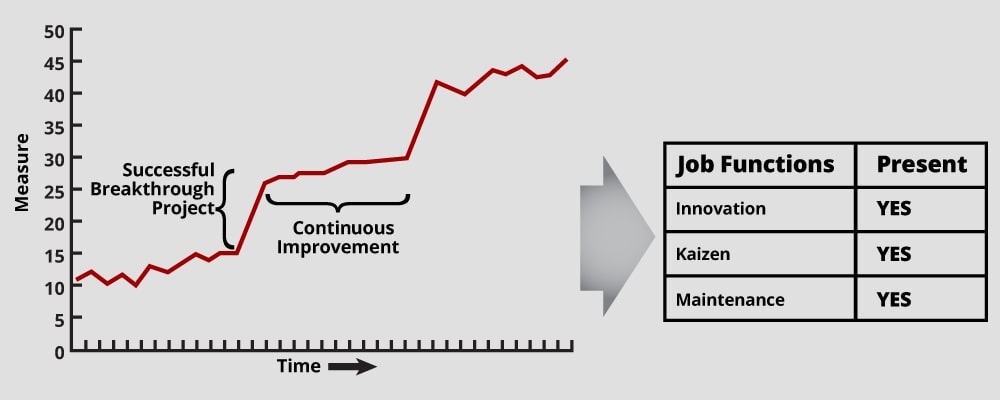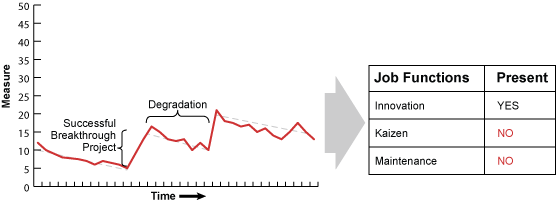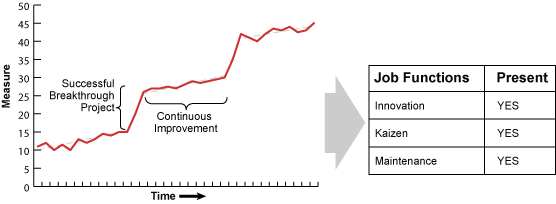
Kaizen is a Japanese philosophy that focuses on continual improvement throughout all aspects of life.
When applied to the workplace, Kaizen activities can improve every function of a business, from manufacturing to marketing and from the CEO to the assembly-line workers.
Kaizen aims to eliminate waste in all systems of an organization through improving standardized activities and processes. By understanding the basics of Kaizen, practitioners can integrate this method into their overall Six Sigma efforts.
What Is Kaizen?
The purpose of Kaizen goes beyond simple productivity improvement. When done correctly, the process humanizes the workplace, eliminates overly hard work, and teaches people how to spot and eliminate waste in business processes.
The continuous cycle of Kaizen activity has seven phases:
- Identify an opportunity
- Analyze the process
- Develop an optimal solution
- Implement the solution
- Study the results
- Standardize the solution
- Plan for the future
Kaizen generates small improvements as a result of coordinated continuous efforts by all employees. Kaizen events bring together a group of process owners and managers to map out an existing process and identify improvements that are within the scope of the participants.
The following are some basic tips for doing Kaizen:
- Replace conventional fixed ideas with fresh ones.
- Start by questioning current practices and standards.
- Seek the advice of many associates before starting a Kaizen activity.
- Think of how to do something, not why it cannot be done.
- Don’t make excuses. Make execution happen.
- Do not seek perfection. Implement a solution right away, even if it covers only 50 percent of the target.
- Correct something right away if a mistake is made.
Kaizen activities cover improvements in a number of areas, including:
- Quality – Bettering products, service, work environment, practice and processes.
- Cost – Reducing expenses and manpower, and use of material, energy and resources.
- Delivery – Cutting delivery time, movement and non-value-added activities
- Management – Improving procedures, training, morale, administration, planning, flow, information systems, documentation and reporting.
- Safety – Decreasing hazardous situations, unsafe working conditions, chances of resource depletion and damage to the environment.
Implementing Kaizen
To generate a Kaizen, everyone involved must begin thinking about their work in a new way – in terms of:
- Now: Present condition
- Next: Desired state
- New: How to reach that state
Typically, implementation of Kaizen occurs in three stages in any organization:
- Encourage participation: Awareness training sessions for all employees are a must. To further encourage employee involvement, promote specific Kaizen activities, and consider distributing monetary or tangible benefits after solutions from Kaizen activities are implemented.
- Training and education: Focused training of associates is required for understanding what is – and is not – the essence of Kaizen. Team leaders should be trained to understand Kaizen in an organizational vision context, which needs to be followed thoroughly in order to achieve desired business objectives. They also must be taught about the necessity of impartial evaluation and strategy for improving participation.
- Quality level improvement: After the training stage is completed, practitioners should continue to focus on long-term implication, widespread application, alignment with organizational objectives and planning objectives. Management should form a core department to carry out Kaizen evaluation and implementation.
Using Kaizen with Six Sigma
Through Six Sigma, companies can make breakthrough improvements in existing processes. Cost savings from breakthrough Six Sigma projects are not always reflected in the bottom line, however. The reason for this is the absence of small improvements, as well as maintenance – establishing standard operating procedures and ensuring everyone follows them. Processes can degrade without systemic monitoring and improvement (Figure 1).

But if a company has a combined system of Six Sigma, a strict adherence to established processes, and local resources who are constantly looking for ways to make their processes better (Kaizen), the situation becomes the best. This puts the organization in a better financial position in the long-run because improvements happen on an ongoing basis in addition to the occasional breakthrough (Figure 2).

Case Study: Reducing Sampling Time
The following case study illustrates the importance of combining Six Sigma with Kaizen activities. At a four-wheeler manufacturer, a Black Belt completed a Six Sigma project on the cycle time of the sampling inspection of completely built units (CBU) of automobiles. The cycle time for sampling inspection at the start of the project was about 24 hours, or three workdays.
At the end of the project, during the Control phase, the time was reduced drastically to about 7.7 hours or one workday, thus reducing two-thirds of the cycle time. The Belt handed over the ownership of the process to a few assigned employees. The associates responsible for the workstation held several Kaizen activities, which benefited the work process as well as improved the motivation level of the employees.
One Kaizen event involved a subprocess in the sampling process – measuring for the turning radius of the car. Before, this part of the sampling process took 20 minutes and required two employees. One employee sprayed water on the tire of the car while another person was driving the car and turning the tire. The employees measured the water mark on the ground to calculate the turning radius. After the Kaizen, the driver would connect a pipe with the water tank under the hood and used that to spray water on the tires while also turning the tires. This idea did not come from a skilled Black Belt, but from a trainee helper. It reduced the time needed for that task from 20 minutes to 5 minutes, and also reduced the manpower needed from two to one.
What was gained was not merely a few minutes in a day-long process, but idea generation in the form of innovative participation. The confidence gained by the employee opened doors to many more Kaizen activities, adding up to sustained improvement after the end of the Six Sigma project.